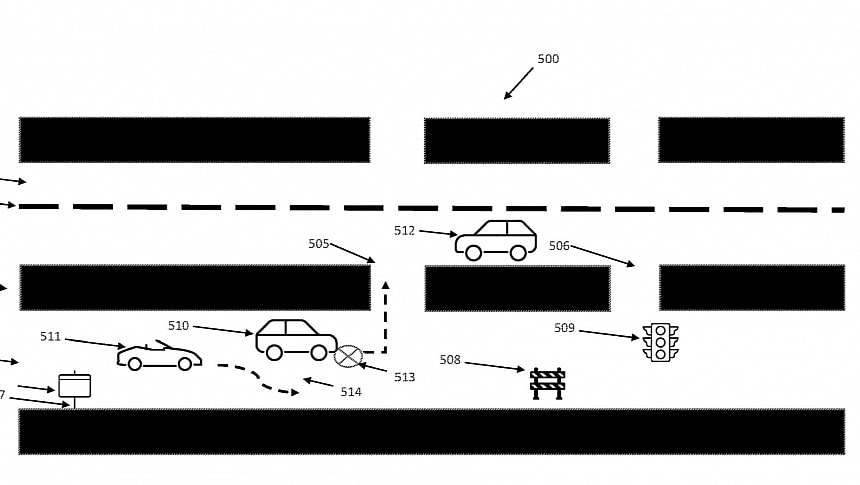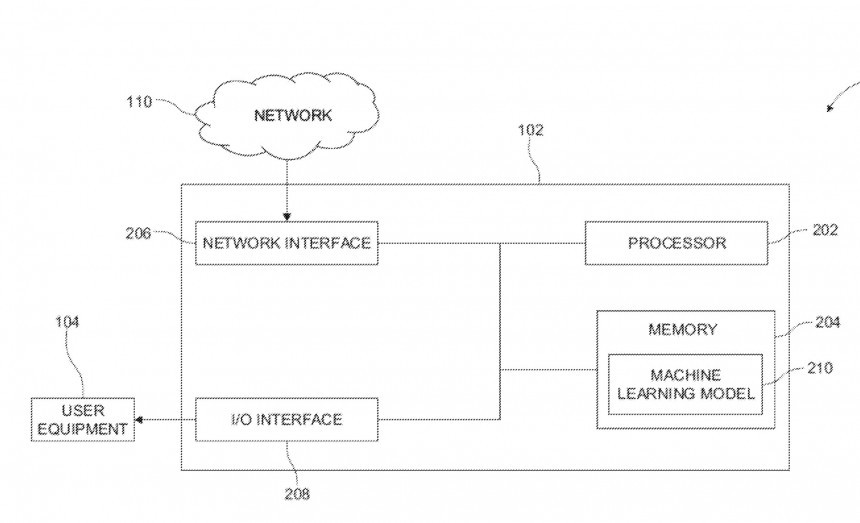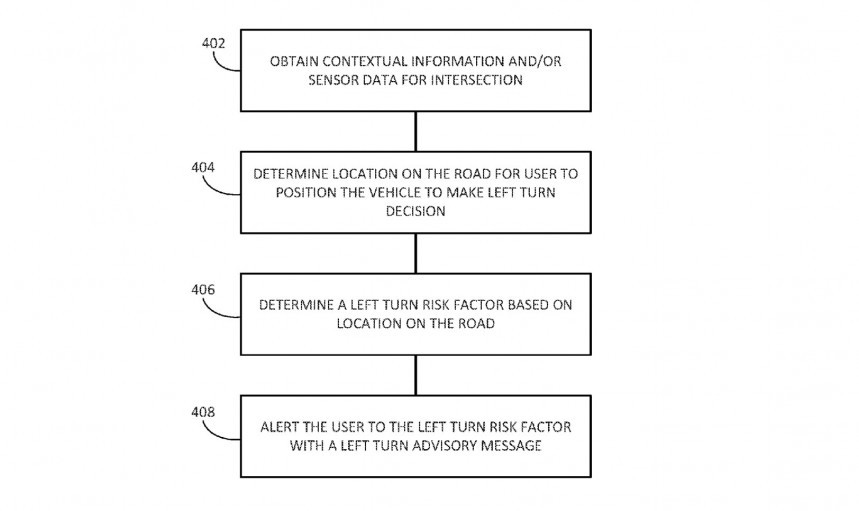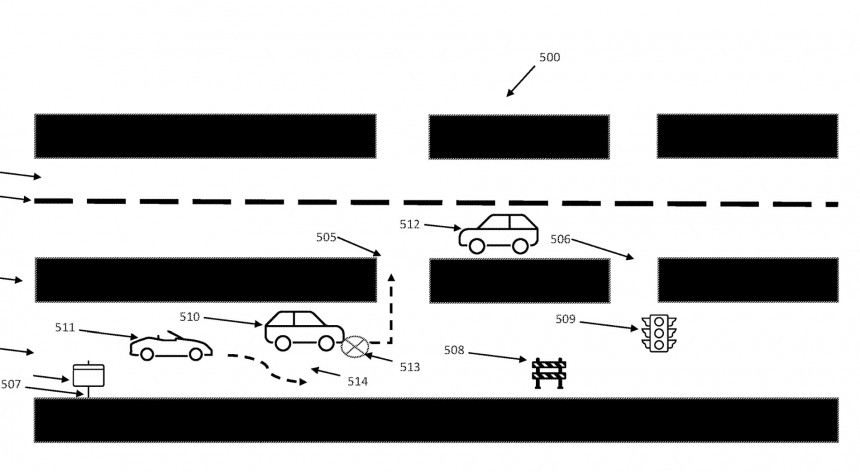While making a left turn in an intersection is a piece of cake for experienced drivers, statistics show that such a maneuver comes with an increased risk of accident. Even if it doesn't end with an accident, not making a left turn correctly could lead to traffic disruptions, eventually causing hard braking and traffic jams.
Some of the navigation apps currently available on mobile devices are already trying to tackle this problem. For example, Waze comes with a dedicated setting to avoid difficult intersections, trying to look for alternatives that don't include left turns that would eventually become a challenge for inexperienced drivers.
Navigation specialist HERE, whose software is now competing against Google Maps on Android and iPhone, has recently patented a new system whose purpose is specifically to make left turns easier.
The idea is called a "method for determining an optimal location to wait for a left turn to minimize traffic impact." This is a self-explanatory name that describes a technology that could help both drivers and autonomous vehicles find the right place where vehicles can wait and eventually make the left turn in a difficult intersection.
HERE starts by explaining that turning left in an intersection "can be very risky when visibility of oncoming vehicles is obstructed by queued opposing left-turning vehicles." We've all been there, and we know it's true, and the first thing most of us do is slow down.
This is what HERE considers an impact on traffic, and its technology is supposed to prevent this.
HERE's system analyzes an intersection based on machine learning and contextual data. It can collect information on every intersection, analyze the data, and decide how a driver should deal with an incoming left turn, indicating the right spot where they should wait for oncoming traffic to allow them to complete the turn. The factors it considers include the vehicle's dimensions, traffic flow, and contextual information on the intersection. It can offer assistance with visual indicators displays on a screen or using augmented reality, projecting the location right in front of the driver's eyes.
In some implementations, the system can also offer voice guidance, such as the instructions provided by a navigation app. The voice can guide you to the right spot to wait for the left turn using distance or other landmarks to make it clear where you should stop.
Another important component of this technology is how it prevents making left turns in a difficult intersection. HERE's systems can anticipate difficult left turns based on collected data, so it can create a database where the likelihood of a left turn to generate an impact on traffic is higher. Based on this data, the system can even suggest avoiding a left turn at a specific intersection, suggesting a new route where the driver can make the turn. More often, the system would recommend turns at intersections with traffic lights – these are considered safer, mainly because drivers can make the left turns after the oncoming traffic stops at the red light.
Because it's based on machine learning, the biggest challenge for this feature will be to train the system to handle every turn correctly. This is where the technology could get even more advanced, using machine learning in conjunction with sensor data – for example, it can collect information from the onboard cameras, allowing the system to analyze the intersection and determine the right spot where the driver should wait.
It doesn't mean it'll always get it right. The first times the system suggests a waiting spot for a left turn, you can observe a better position, but the system learns and gets better as drivers make the turns without impacting traffic.
HERE's system is based on a complex approach where every vehicle on the road contributes with traffic data. In a world where autonomous vehicles would become more common, the traffic impact generated by vehicles making a left turn would be significantly reduced, eventually leading to improved traffic flow, less frequent slowdowns at intersections, and a reduced likelihood of accidents.
For now, HERE's idea is still in the patent stage, but the company exploring improvements for its navigation systems in this direction is definitely good news. However, as with everything in the patent stage, there is no guarantee that this concept will make it to production. Companies sometimes patent their ideas just to protect them in case someone else comes up with a similar system, so don't hold your breath for more convenient left turns just yet.
The best thing you can do is to always pay close attention to oncoming traffic and only make the left turn when you're absolutely sure the oncoming lanes are clear. Slow down when entering the intersection, use the designated lane for a left turn, and don't forget to check your left-side mirror, as you never know what's there.
Navigation specialist HERE, whose software is now competing against Google Maps on Android and iPhone, has recently patented a new system whose purpose is specifically to make left turns easier.
The idea is called a "method for determining an optimal location to wait for a left turn to minimize traffic impact." This is a self-explanatory name that describes a technology that could help both drivers and autonomous vehicles find the right place where vehicles can wait and eventually make the left turn in a difficult intersection.
HERE starts by explaining that turning left in an intersection "can be very risky when visibility of oncoming vehicles is obstructed by queued opposing left-turning vehicles." We've all been there, and we know it's true, and the first thing most of us do is slow down.
HERE's system analyzes an intersection based on machine learning and contextual data. It can collect information on every intersection, analyze the data, and decide how a driver should deal with an incoming left turn, indicating the right spot where they should wait for oncoming traffic to allow them to complete the turn. The factors it considers include the vehicle's dimensions, traffic flow, and contextual information on the intersection. It can offer assistance with visual indicators displays on a screen or using augmented reality, projecting the location right in front of the driver's eyes.
In some implementations, the system can also offer voice guidance, such as the instructions provided by a navigation app. The voice can guide you to the right spot to wait for the left turn using distance or other landmarks to make it clear where you should stop.
Because it's based on machine learning, the biggest challenge for this feature will be to train the system to handle every turn correctly. This is where the technology could get even more advanced, using machine learning in conjunction with sensor data – for example, it can collect information from the onboard cameras, allowing the system to analyze the intersection and determine the right spot where the driver should wait.
It doesn't mean it'll always get it right. The first times the system suggests a waiting spot for a left turn, you can observe a better position, but the system learns and gets better as drivers make the turns without impacting traffic.
For now, HERE's idea is still in the patent stage, but the company exploring improvements for its navigation systems in this direction is definitely good news. However, as with everything in the patent stage, there is no guarantee that this concept will make it to production. Companies sometimes patent their ideas just to protect them in case someone else comes up with a similar system, so don't hold your breath for more convenient left turns just yet.
The best thing you can do is to always pay close attention to oncoming traffic and only make the left turn when you're absolutely sure the oncoming lanes are clear. Slow down when entering the intersection, use the designated lane for a left turn, and don't forget to check your left-side mirror, as you never know what's there.





















